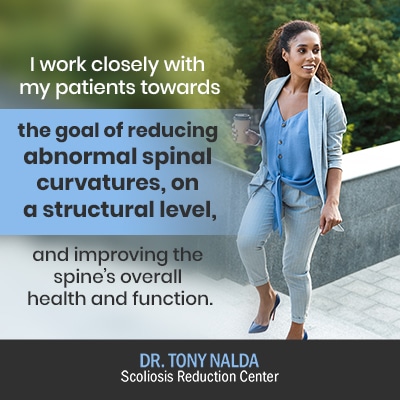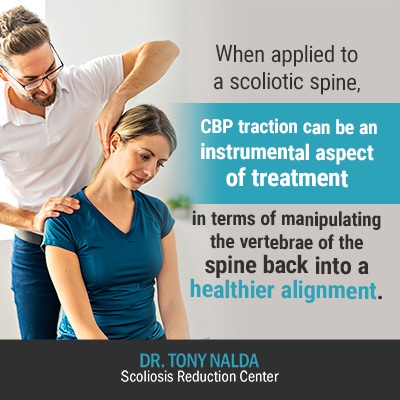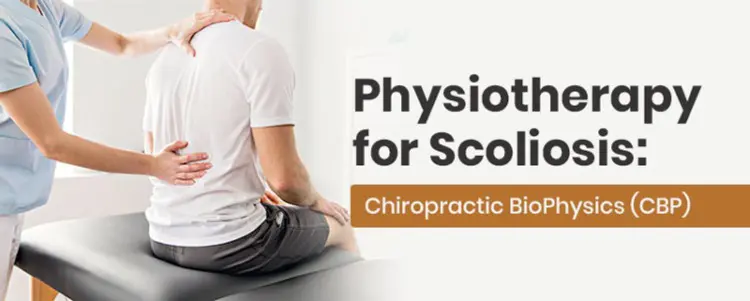There are many different approaches to treating structural conditions of the spine like scoliosis. While some following the traditional approach might argue that observation and surgery is the best option, there is a dynamic and integrative approach that features the union of chiropractic care and biophysics as a form of physiotherapy. Keep reading to find out how chiropractic biophysics (CBP) can impact scoliosis positively.
Physiotherapy for scoliosis works to restore spinal alignment through improving muscle asymmetry, elongating the spine, and building stronger posture; when this includes chiropractic biophysics, scientific principles are applied to scoliosis-specific chiropractic care to alter the spine’s structure.
There is a big difference between general chiropractic and scoliosis-specific chiropractic. As a complex structural spinal condition, in order to treat scoliosis effectively, it has to be impacted on a structural level. Chiropractic biophysics is an advanced approach to chiropractic care of the spine to better understand and promote spinal alignment. Before defining what the principle and practice of chiropractic biophysics involves, let’s talk about scoliosis and chiropractic in general terms.
What a Scoliosis Diagnosis Means
If a person is diagnosed with scoliosis, their spine has an abnormal sideways curvature, with rotation, of a certain size.
As the spine is naturally curved for the important reasons of increasing spinal strength, flexibility, and enabling it to evenly distribute stress, a loss of one or more of its healthy curves comes with consequences.
Not only does an abnormal spinal curvature mean the spine’s overall health is impacted, the fact that it’s no longer in a healthy alignment means its function can be impaired.
The spine is made up of bones called ‘vertebrae’, and these vertebrae are stacked on top of one another and separated by intervertebral discs. When an abnormal curvature develops, certain vertebrae become tilted, and the spine is no longer in an ideal alignment.
While the spine’s natural curves have an acceptable range from one person to the next, if a curvature falls outside of that normal range, this is when the spine is misaligned to a point where problems occur.
If an abnormal sideways spinal curvature has rotation and a minimum Cobb angle of 10 degrees, this is diagnosed as scoliosis.
Cobb angle is a measurement obtained via X-ray that tells me how far out of an alignment a scoliotic spine is, and it also places a condition on its severity scale of mild, moderate, severe, and very severe:
- Mild scoliosis: Cobb angle measurement of between 10 and 25 degrees
- Moderate scoliosis: Cobb angle measurement of between 25 and 40 degrees
- Severe scoliosis: Cobb angle measurement of 40+ degrees
- Very-severe scoliosis: Cobb angle measurement of 80+ degrees
The higher the Cobb angle, the more out of alignment a spine is, the more tilted the vertebrae are, and the more likely the condition is to cause pain (more so in adults), postural changes, and functional deficits.
So we know the roles that the spine’s natural curvatures play, and we know what happens, and what it means, when a spine becomes misaligned, so where does chiropractic come in?
Treatment for Scoliosis: Chiropractic Care
As mentioned earlier, there is a big difference between general chiropractic and scoliosis-specific chiropractic.
While general chiropractic can make adjustments, address a number of spinal conditions and injuries, and reduce pain, when it comes to scoliosis, the complex nature of the progressive condition necessitates a highly specific approach.
As a CLEAR-certified scoliosis chiropractor, I know the spine, its biomechanics, and I know scoliosis. I can apply numerous chiropractic principles and practices to scoliotic spines to induce structural changes that help restore the spine’s natural curves and alignment.
Here at the Scoliosis Reduction Center®, I offer patients a comprehensive chiropractic-centered functional approach that combines scoliosis-specific chiropractic care, in-office therapy, custom-prescribed home exercises, and specialized corrective bracing.

I work closely with my patients towards the goal of reducing abnormal spinal curvatures, on a structural level, and improving the spine’s overall health and function.
Chiropractic biophysics (CBP) is a concept of chiropractic that uses a scientific approach to address the importance of spinal alignment by assigning geometric shapes to spinal curvature characteristics; this is a methodology that helps me craft comprehensive and customized treatment plans.
What is Chiropractic BioPhysics?
The term itself, ‘chiropractic biophysics’, sounds highly scientific and complex, so let’s break it down into its individual components, and then apply it to scoliosis.
We know that ‘chiropractic’ refers to a branch of medicine focusing on the diagnosis and treatment of misalignments of the joints, particularly the spinal column. As the spine works in tandem with the brain to form the central nervous system, chiropractic acknowledges the far-reaching effects that spinal conditions can have on other parts and systems of the body.
‘Biophysics’ is the scientific concept of applying the laws of physics to biological systems. Thus ‘chiropractic biophysics’ is the medical practice of applying scientific principles to the diagnosis and treatment of joint and spinal conditions in an effort to bring about long-term pain relief through positive structural changes.
Also known as ‘CBP’, this form of chiropractic is an advanced technique that takes a lot of extra training, education, and equipment to understand and apply.
Prior to the development of CBP, there was a gap in the data on established average values for the shape of the spine and its curvatures. As CBP assigned geometric shapes to measure the spine’s curvatures, these shapes could also be applied to unhealthy curvatures for a more comprehensive representation and understanding of spinal curves and alignment.
As a CBP practitioner, I don’t just have the knowledge and experience of performing targeted chiropractic adjustments; I’m trained in the use of science to diagnose and treat problems of the spine.
I examine spines physically, and through X-ray, and measure how far they have deviated from a natural alignment, and then design a treatment plan that works towards moving the spine back towards an established normal value.
CBP studies were some of the first to consistently identify and document how postural issues, such as forward head posture, introduces adverse spinal tension to the neck and middle back, and were also among the first to document how these issues affect the spine structurally and how to correct them by changing the shape of the spine.
CBP training gives a more well-rounded understanding of the different types of deviations a spine can experience, and matching each deviation with a technique for correcting it means a customized and specific protocol is valued and applied; this is also the approach that the nature of scoliosis necessitates.
Scoliosis and Chiropractic Biophysics
CBP does not undervalue the importance of posture, but instead, analyzes the effect of posture, and other spinal issues, on spinal curvatures, spinal alignment, and how to produce changes that address these issues on a structural level.
As mentioned, scoliosis involves an abnormal sideways curvature that rotates and causes the spine to deviate from a natural alignment. CBP uses traction, a dynamic therapy that differs from general physiotherapy for the back that relies on exercises, stretches, adjustments, and alternating heat and ice to bring about short-term pain relief.
Traction involves a sustained stretch that engages joints that are relaxed; its intent is to change the structure of ligaments that aid in maintaining the spine’s shape, which differs from one patient to the next.

While traction is also used to decompress injured discs, CBP uses a type of traction that involves bending and pulling to structurally alter the shape of the spine. When applied to a scoliotic spine, CBP traction can be an instrumental aspect of treatment in terms of manipulating the vertebrae of the spine back into a healthier alignment.
For those experiencing scoliosis-related pain, this can bring about long-term pain relief, unlike the short-term pain relief that characterizes general chiropractic and physiotherapy treatment for scoliosis that doesn’t impact the condition structurally.
CBP biophysics in scoliosis treatment combines traction, chiropractic adjustments, specific exercises, and focused stretching, and as I craft a treatment plan involving these disciplines, and others when needed, it’s based on the unique shape of each patient’s spine.
This combination can produce measurable changes to the shape of the spine, and these changes, as they are structural, are long term. They allow the spine to heal, be better supported and stabilized by surrounding musculature, and encourage the spine’s return to a healthy and natural alignment in the form of a curvature reduction.
Here at the Scoliosis Reduction Center®, my patients can access the benefits of multiple treatment disciplines, including applying the principles of chiropractic biophysics as a form of physiotherapy, that can produce more structural and long-term results.
Conclusion
The spine is a complex structure whose health is dependent upon its ability to maintain its natural curvatures and alignment.
In order for a spine to function optimally, meaning facilitate flexible movement, spinal strength, and distribute mechanical stress that’s incurred during movement, the spine needs to be properly aligned.
Chiropractic care can be highly effective in treating scoliosis, but only if that care is scoliosis-specific. As scoliosis is a progressive structural condition, it can only be managed and treated effectively if that treatment can induce a structural change in the shape of the spine.
Chiropractic biophysics uses scientific principles to assign values to the curves of the spine, enabling a better understanding of the deviations that can occur within these curves, the subluxations they can cause, and how to apply therapies, such as traction, to work towards correcting these deviations by altering the shape of the spine structurally.
Here at the Scoliosis Reduction Center®, I have the training, certifications, knowledge, and experience to apply multiple principles and treatment disciplines. I use these different methodologies to craft comprehensive and customized treatment plans that address the specifics of each patient’s spinal deviations.
When it comes to CBP in scoliosis treatment, this is an advanced technique of chiropractic care that has the potential to impact the condition on a structural level, which is precisely what’s needed to preserve the scoliotic spine’s overall health and function.





